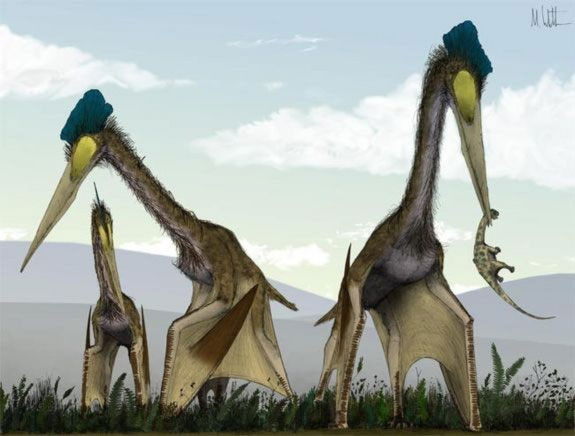The world was once dominated by a toothless giant
Flying lizards with giant wingspan once ruled the sky 60 million years ago and played an important role in the late Cretaceous ecosystem. Although large, these animals have no teeth.
The giant flying lizard of the family Azhdarchidae has a wingspan of up to 12 meters and has no teeth. The new study shows that they replace their toothed relatives about 90 million years ago to become the dominant species after high concentrations of carbon dioxide kill important marine microorganisms, leading to greatness. strains, Livescience said.

Azhdarchid flying lizard.(Illustration: Mark Witton Darren Naish)
'The change of the dominant species from toothless lizards without teeth seems to reflect some fundamental changes in the Cretaceous ecosystem that we still don't understand' , Alexander Averianov from the Academy of Sciences Russia said.
Fossil records suggest that flying lizards are most likely the first flying vertebrates and they appeared 220 million years ago. The name Azhdarchidae is of Persian origin "aždarha" meaning dragon.
Scientists know very little about the flying lizards, the fossils most largely incomplete are the late Cretaceous fossils. Most fossils of flying lizards Azhdarchidae are preserved in sedimentary layers, their bones are smaller than dinosaur bones and there is little left, so archaeologists face many difficulties to estimate the period. their living.
After examining 54 Azhdarchidae fossils, Averianov came to the conclusion that most of the toothless lizards could live near the lake and along the coast, however the lack of fossils led to some scientists Another school 'inflates' the number of flying lizards and misclassifies some bone fragments.
In an effort to learn more about the evolution of flying lizards, scientists created an online database of fossils called PteroTerra , a map showing the distribution of species Ancient s using Google Earth. The results of the study are published in ZooKeys magazine.
- Giant beasts that once dominated Australia in prehistoric times
- The mystery of the toothless 'mini' dolphin lived 30 million years ago
- Roll on 10 giant monsters extinct on Earth
- The giant bird once dominated the Antarctic sky 50 million years ago
- Monsters that dominated the prehistoric world
- Dinosaurs dominated the earth completely by luck
- These are the most giant creatures that appear on Earth
- Dinosaurs are the most 'black' creatures on Earth's history
- Mosasaur sea lizard once dominated the ocean
- The largest big animals on the planet (Part 2)
- 11 species of giant fish are in danger of extinction
- SpinLaunch: Startup uses the
 Discovered an ancient centipede fossil 99 million years old
Discovered an ancient centipede fossil 99 million years old Discovered bat-like dinosaurs in China
Discovered bat-like dinosaurs in China Discovered a 200-year-old bronze cannon of the coast
Discovered a 200-year-old bronze cannon of the coast Discover 305 million-year-old spider fossils
Discover 305 million-year-old spider fossils